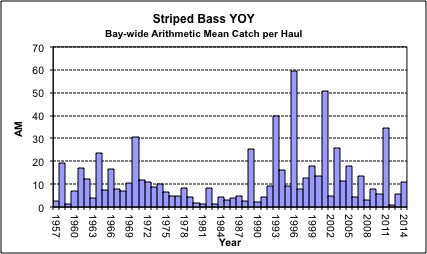MD DNR 2014 YOY Figures
MD has just released the 2014 young of the year figures for striped bass. The graph below shows the arithmetic mean numbers:
The 2014 number is 11.02. This is sure to be a great number for the spin doctors. Looking at it positively this may be the best of the last three years, but in reality this is another very mediocre number and certainly not one that will allow continuing harvesting striped bass at current levels. One of our SF board members once said that a classic sign of a species in trouble is when both the lows and the highs of spawning success are in decline. The average of the last 3 years is now about 5.9 which is only slightly better than the levels experienced during the crash of the late 70s and 80s and just half of the long term average of 11.8 taken from 1957 through 2014.
In the graph above you will note that the large years happened quite regularly throughout the 1990s; these big years were needed to produce the great fishing that encouraged angler participation, tackle sales, and sustained the guiding industry. In fact there were five years within the 15 year period of 1989 to 2003 that had a young of the year counts above 20. In the 11 years from 2004 through 2014, there has been only 1.
Of extra concern is that while that one year class – 2011- was very large those fish should be about 17 or 18 inches this fall and they should be everywhere, but no one seems to be finding that to be the case. In fact the entire summer of 2014 was very spotty for school bass fishing. Some locations along the coast reported quite a few while many normally good spots had almost none or only a few good days. However many there will be as three year olds there will surely be many fewer in the future as they are harvested first in the Chesapeake Bay and later the coastal fisheries. So in summary we feel that while the 2014 year class is not bad news, it provides no reason to abandon the major reductions in harvest the ASMFC will be contemplating on Wed. 10/29.
Click here to view the MD DNR young of the year page. Click on either geometric or arithmetic mean to download the excel document. (If the pages opens up and asks for a password, but just X that window out and the document will open up anyway.)
SF Full Comments to ASMFC Draft Addendum IV to Amendment 6
STRIPERS FOREVER COMMENTS TO DRAFT ADDENDUM IV TO AMENDMENT 6 TO THE ATLANTIC STRIPED BASS INTERSTATE MANAGEMENT PLAN FOR PUBLIC COMMENT
Stripers Forever is a not for profit organization that advocates for the conservation and responsible stewardship of striped bass.
Stripers Forever (SF) believes that the Atlantic States Marine Fisheries Commission (ASMFC) has given too much consideration to reducing potential social and economic impacts on the commercial striped bass fishery, and too little on managing the striped bass fishery as a public resource for the greatest user of this resource, the recreational angling community and the industry it supports. The signs of diminishing abundance have been ignored for years and have finally resulted in yet another attempt to follow the failed policies of the past instead of actually doing something proactive to improve fish abundance. The draft addendum for public comment at best proposes measures that fit the “too little, too late” model that has plunged this resource toward pre-moratorium abundances and now proposes measures that have a 50% probability of failure.
We believe that ASMFC should take as large a bite out of this apple as it can and we support the following options:
Proposed Fishing Mortality Reference Points (2.5.1) While the Technical Committee has been candid in their assessment of risks associated with the proposed new reference points, managing under the old reference points (Option A) has failed to stabilize SSB. We support the 2013 Benchmark Stock Assessment F Reference Points (Option B) for both coastwide and Chesapeake Bay fisheries because they represent the most
conservative approach to the problem.
Proposed Fishing Mortality Reference Points (2.5.2) We support Option B since the Technical Committee does not have the needed information to set up separate reference points for separate Chesapeake Bay management.
Albemarle Sound Reference Points (2.5.3) We have no comment on this question.
Timeline to Reduce F to the Target (2.6). Since the one year time frame represents the most aggressive approach to reaching the stated goals, we support Option A.
Proposed Management Scenarios (3.0). It seems redundant and confusing to select Option A under section 2.6 and then to have to select Option B in this section to support taking the largest possible reduction (25% of the 2013 harvest) in one year. We support Option B.
Proposed Recreational Fishery Management Options, Coastal Recreational Fishery.
Stripers Forever supports option B1 which is a one fish bag limit with a minimum size of 28-inches. We would prefer to see an option for a 28-34” slot but with a total bag limit of one fish, but it is not offered.
Proposed Recreational Fishery Management Options, Chesapeake Bay.
Since the objective is to increase the SSB, it doesn’t make sense to kill the largest, most productive spawners we already have while we wait for the 2011 year class to provide a greater number of smaller fish to make up for trophy fishing. Option B12 would effectively end the spring trophy season where the Bay jurisdictions get to kill large spawners that don’t count toward their coastwide quota. We support Option B12.
Proposed Commercial Fishery Management Options. The statement, “It is important to note none of the management options presented in the tables achieve a 25%
reduction from 2013 harvest” reveals an apparent inconsistency regarding the commitment to treat all stakeholders equitably. For the Coastal Commercial Fishery, it appears that Option B16 (taking a reduction of 25% from the Amendment 6 quota) is the only choice provided. It isn’t clear why this fishery isn’t held to the 2013 harvest baseline like the others.
The consideration of alternate options for the Chesapeake Bay Management Area Commercial Fishery seems unwarranted. The Bay jurisdictions claim they had a lower quota in 2013 so they would like to have their cut come from the 2012 harvest. Missing from this discussion was the fact that the Bay jurisdictions increased their quota (and probably harvest) for 2014 when the exploitable biomass increased due to the 2011 year class reaching 18” in length. We support Option B17 to take the 25% from the 2013 commercial quota. The Bay commercial fishermen have already been repaid for whatever happened in 2013.
SB is opposed to commercial quota transfers. If a state can’t catch their quota, it may be because they don’t have enough fish. It doesn’t make sense to transfer that quota to another state that does have fish and maintain the coastwide harvest to help ensure that more states won’t have enough fish next year. We support Option A – no commercial quota transfers.
All stakeholders should be fishing on the same size limits. We support Option A to constrain the commercial fishery in each jurisdiction by the same size limits established for that jurisdiction’s recreational fishery.
Compliance Schedule (4.0). The schedule has been compressed by the protracted debate over Chesapeake Bay reference points but the end point seems firm – no later than January 1, 2015, as it should be.
Sincerely;
Ken Hastings
Atlantic States Marine Fishery Commission Policy Coordinator for Stripers Forever
——————————————————————————
Send written comments to :
Mail: Mike Waine, Fishery Management Plan Coordinator
Atlantic States Marine Fisheries Commission (Subject: Draft Addendum IV)
1050 North Highland Street Suite 200A-N
Arlington, VA 22201
Phone: (703) 842-0740
Fax: (703) 842-0741
Email: mwaine@asmfc.org; (Subject: Draft Addendum IV)
NOAA National Saltwater Recreational Fisheries Policy
The National Oceanic and Atmospheric Administration is in the process of overhauling it recreational fishing policies. Stripers Forever sees this as an opportunity to create a new national policy that will guide and improve local fishery management decisions that have not been good for the needs or rights of recreational salt water fishermen.
Here are Stripers Forever’s comments to NOAA:
Stripers Forever, a conservation and recreational advocacy organization focused on striped bass along the East Coast offers the following comments on NOAA recreational fishing policy.
NOAA must stand up in the fishery management process for recreational fishing. On a local basis it is very difficult for recreational fishing to get the consideration it is due because commercial fishing has historically been seen as the more important use of the resource. Politicians are very slow to take new and forward thinking positions that they do not thoroughly understand, and these politicians control the appointment process for all aspects of local fishery management.
The federal government often has a different view of wildlife management than the states because it is not as easily controlled by small segments of the public. The history of waterfowl management provides one of the clearest examples of how the influence of the federal government was needed to change the fishery management practices within the states. Action by the federal government could now be very important in improving recreational fishing opportunities, and this would overall be very beneficial.
There are a number of strong justifications for giving a great deal more consideration to recreational fishing than it currently receives.
I. Issues that justify greater allocations and management consideration for recreational fishing.
A. Personal Use Allocations
SF sees recreational fishing as members of the public directly accessing for their own personal use and enjoyment a resource that all citizens have an equal right to. The precedents are clear in wildlife management that this individual right has the highest primacy when compared to other harvesting.
In many cases today we see commercial fishing quotas taking such a bite out of a scarce resource that a reasonable personal use harvest is not possible, and this is simply wrong. NMFS should stand up for the rights of individual citizens to have a fair harvest allocation before commercial fishing harvests the surplus – if in fact there is any surplus.
B. Conservation
Because of the comparatively inefficient and non-invasive equipment used by recreational fishers they do not take large percentages of a fish population from a defined area at any one time. Recreational equipment also tends to be far less harmful to the environment than commercial gathering techniques such as bottom dragging, nor does it cause ghost fishing issues that take place with the use of gill nets. Also, because there is no profit motive fishing will generally not occur beyond taking the bag limit. The greater conservation values in recreational fishing activity when compared to commercial fishing should be recognized and supported. If, for instance, a fishery or a fishing location cannot support commercial fishing activity recreational activities should not be automatically banned just because commercial fishing activities are not appropriate.
C. Economics
In most or perhaps all fisheries that are participated in by recreational anglers the public benefits by receiving a greater amount of economic activity than if the same fish were taken by commercial fishing. There is no justification for harvesting the fish commercially if it generates less economic activity than would be available through recreational fishing. In spite of rhetoric about providing seafood for people, all commercial harvest does when confronted with a limited resource is to take fish away from those willing to harvest their own and sell them to someone else. No additional seafood can be created, and less economic activity and jobs are produced in the process.
D. Social Benefits
The great American conservationist Gifford Pinchot said: “Conservation is the foresighted utilization, preservation and/or renewal of forests, waters, lands and minerals, for the greatest good of the greatest number for the longest time.” Surely our continued management of fish to fulfill the desires of the small number of people within the commercial fishing industry provides benefits for less people than a recreational fishery with many times the participants. For those fish enjoyed by recreational fishing it is obvious that the greatest social benefits can be achieved by optimizing the populations of those species to get the most public participation in the fishery.
E. Right Thing To Do
It is obvious to all thinking individuals that we should not destroy our populations of ocean fish, yet that is exactly what we have done. Commercial fishing interests have been able to leverage local politicians and on up the political ladder to have the greatest influence of any user group on the fishery management process. The result has been the essential destruction of our marine fish populations. Clearly these practices have to end and we need to rebuild our fishery populations. It will not be possible to do this and manage them allowing as much commercial harvest as we have in the past. NOAA has the ability to greatly influence the fishery management process for the better by adopting and promoting policies that recognize the rights of recreational anglers and the benefits of recreational salt water angling. Typically local fishery management has no guiding policies of any kind, and NOAA’s policies will become the benchmark.
II. Additional issues that must be addressed to improve recreational fishing experiences and enjoy the associated benefits.
- “Willingness to Pay (WTP)” must be replaced with some other more practical allocation metric – one that the managers can understand and apply today. The fact that each individual recreational participant is a citizen with equal rights to all others must be recognized.
- Minimum standards for recreational fisheries must be established – a hard catch per unit effort (CPUE) should be set where possible to ensure an acceptable probability of catching a fish.
- Abundance must be evaluated in terms of the minimum catch per unit effort established for a “successful” recreational fishery in recognition of the fact that it takes more fish to have a successful recreational fishery. For fisheries participated in by recreational anglers it must be formally recognized that maximum sustainable yield (MSY) is not an appropriate concept.
- Better effort data must be continuously collected for the recreational fishery. MRFSS and MRIP have been relied on for years, not because they provided the best data but because they were easiest to implement.
- Recreational participation in the management process at the council and commission level must be increased. These venues are traditionally saturated by commercial interests. For many jurisdictions, there is essentially very little recreational representation at the ASMFC.
- We need to stop hiding behind phrases like “fair and equitable,” and words like “reasonable” that are poorly defined in the context of fisheries. The federal recreational fisheries policy should either stop using these terms or give them some teeth in practical terms that can influence policies. When the law says that allocation policies shall “Not permit a particular individual, corporation, or other entity to acquire an excessive share of fishing privileges,” what does the word “excessive” mean?
Sincerely:
Brad Burns President of Stripers Forever
You also have the right to make your own comments. Here is the link to where you can do that on your own.
If we don’t speak up we will be ruled by those who do. Let your opinions be known.
“Where have all the Stripers Gone?”
The most important game fish in local waters is in deep trouble. The writer, a renowned fisherman and longtime conservation columnist for Salt Water Sportsman, thinks he knows why. BY RIP CUNNINGHAM
EXCERPT:
“Scuttlebutt and bad news have the tendency to travel faster than good news or the real facts. That’s human nature and nowhere is it truer than around the docks, where all anglers become possessive about their favorite quarry. When something changes for striped bass, New England’s premier sport fish, and that change is perceived to be bad news, you can be sure the sky will soon be predicted to fall.
As this is being written, there is a sense that “the sky is falling.” Stripers are anadromous fish, meaning they breed in fresh water and live most of their mature lives in salt water. The fish we see around the Cape and Islands spawn in the Chesapeake Bay, and to a much lesser extent in the Hudson River, and migrate up the coast to Maine and beyond. At one time there may have been small local populations that bred in New England rivers, but industrial development extirpated virtually all of those stocks. Stripers can live to thirty years; the largest on record was a 125-pound female caught off North Carolina in 1891. On the Island, the largest fish entered in the Martha’s Vineyard Striped Bass and Bluefish Derby was a sixty-pound lunker caught by Dick Hathaway in 1978, though there is anecdotal evidence of larger fish that were not entered.
For many on the Vineyard and around the Northeast, the spring arrival of stripers is nothing short of a religious experience, and when something happens to delay or change that experience the news impacts the entire year’s fishing season. Perception soon becomes reality.Bad news is jet fuel for the internet, and by mid-summer alarmed anglers on the waterfront and the internet are howling: “Where are the fish? They haven’t arrived here yet.” “Is the population crashing?” “There aren’t any big fish.” “There aren’t any small fish!” “There aren’t any freaking fish at all!”
All of this is happening with striped bass now, at a time when some thought we might have turned a corner and headed in a sustainable direction. Overfishing and poor environmental conditions led to the collapse of the fishery in the 1980s, but through intensive management by the Atlantic States Marine Fisheries Commission the stocks began to rebound. Some states implemented moratoria on striper fishing; Massachusetts was not one of them, but between 1985 and 1993 the derby did its part by not including bass in the tournament. By 1995, the striper population was considered to be fully restored.
So what is the problem today? Or more accurately, what are the problems? Not surprisingly for a migratory fish that relies on both rivers and the ocean and is fished by both commercial and recreational anglers, there are multiple factors involved. And as is often the case for an environmental issue, one’s opinion on which factor plays the largest role often depends on one’s particular perspective and bias. We all see things through our own eyes. The factors include, but are not limited to, several years of poor spawning success, too much fishing pressure on mature – eight-years-old and up – fish, and habitat and forage issues…”








